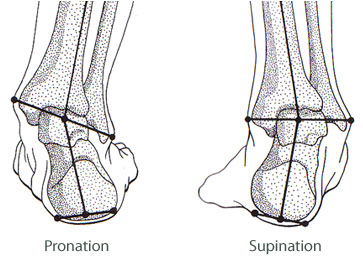Patellofemoral Pain Syndrome (PFPS), Chondromalacia, and Infrapatellar Tendinitis are all knee pain culprits. PFPS pain is primarily in the front of your knee. Chondromalacia is primarily under the knee cap. Infrapatellar Tendinitis is pain in the distal kneecap into the infrapatellar tendon (inflammation of the patellar tendon where it inserts in the tibia--distal part of the patella and proximal tibia).


Chondromalacia is caused by the posterior surface of the patella not properly tracking in the femoral groove and causes the cartilage under the patella to become damaged by softening or wearing it away. Be sure to check out this video on YouTube for help with both Chondromalacia and Patellofemoral Pain: http://youtu.be/xWC4fLSSV6E
from 6/25/12 Post on Runner's v Jumper's Knee
How our feet move directly impacts how the knee functions just as how tight or weak our thigh muscles and hip function directly impacts how the knee functions. Be sure to check out the Workout Tidbits Page for help with good training/form.
Law of Facilitation The body subscribes to the law of facilitation, meaning that the body will achieve the desired movement following the path of least resistance. If your body has any mobility-stability compromises, you will end up with dysfunctional movement causing inevitable breakdowns at your weakest link. This is corrected by focusing on moving correctly as opposed to just moving. A great example is the squat and the push up. If you just move through either of these movements regardless of incorrect movement just to say you got the move done, you are actually causing layers of damage to muscular and joint function which will impede your progress to moving correctly in those and other movements. An excellent way to get in touch, stay in touch, as well as improve your mobility-stability issues is to STRETCH. Yoga is an excellent way to accomplish this. When you are stretching, regardless of what modality you use, pay attention to what is tight and what is overcompensating for your “weak links” and communicate those findings to me during our sessions. We can work together to improve your movements so your body doesn’t have to “compromise” to move.


Chondromalacia is caused by the posterior surface of the patella not properly tracking in the femoral groove and causes the cartilage under the patella to become damaged by softening or wearing it away. Be sure to check out this video on YouTube for help with both Chondromalacia and Patellofemoral Pain: http://youtu.be/xWC4fLSSV6E
from 6/25/12 Post on Runner's v Jumper's Knee
Runner's Knee or Patellofemoral Pain Syndrome (PFPS) is anterior (front) knee pain and is often confused with chondromalacia (which is a softening or wearing away of the cartilage behind the patella resulting in inflammation and pain). PFPS can occur either with overuse, repetitive loading activities causing abnormal stress to the knee joint, or through biomechanical abnormalities altering the tracking of the patella and alignment, or muscle dysfunction and tightness. If you have pain with running, ascending or descending stairs, squatting, or prolonged sitting, or if you have a gradual achy pain that occurs behind or underneath the patella, or knee stiffness for a prolonged period of time, then you might want to look into the possibility of PFPS and treatment.
Jumper's Knee or Infrapatellar Tendinitis is an overuse syndrome characterized by inflammation of the patellar tendon. Typical in sports such as basketball, volleyball, jumping sports producing significant strain in the tendinous tissues. Causes can be poor running style, overtraining, sudden changes in training surface, lower-extremity inflexibility, or muscle imbalance. If you have pain in the distal kneecap into the infrapatellar tendon or pain when running, walking stairs, squatting, prolonged sitting and you do a lot jumping activities, you might want to look at your footwear, training techniques and frequency.
Jumper's Knee or Infrapatellar Tendinitis is an overuse syndrome characterized by inflammation of the patellar tendon. Typical in sports such as basketball, volleyball, jumping sports producing significant strain in the tendinous tissues. Causes can be poor running style, overtraining, sudden changes in training surface, lower-extremity inflexibility, or muscle imbalance. If you have pain in the distal kneecap into the infrapatellar tendon or pain when running, walking stairs, squatting, prolonged sitting and you do a lot jumping activities, you might want to look at your footwear, training techniques and frequency.
How our feet move directly impacts how the knee functions just as how tight or weak our thigh muscles and hip function directly impacts how the knee functions. Be sure to check out the Workout Tidbits Page for help with good training/form.
Law of Facilitation The body subscribes to the law of facilitation, meaning that the body will achieve the desired movement following the path of least resistance. If your body has any mobility-stability compromises, you will end up with dysfunctional movement causing inevitable breakdowns at your weakest link. This is corrected by focusing on moving correctly as opposed to just moving. A great example is the squat and the push up. If you just move through either of these movements regardless of incorrect movement just to say you got the move done, you are actually causing layers of damage to muscular and joint function which will impede your progress to moving correctly in those and other movements. An excellent way to get in touch, stay in touch, as well as improve your mobility-stability issues is to STRETCH. Yoga is an excellent way to accomplish this. When you are stretching, regardless of what modality you use, pay attention to what is tight and what is overcompensating for your “weak links” and communicate those findings to me during our sessions. We can work together to improve your movements so your body doesn’t have to “compromise” to move.

No comments:
Post a Comment